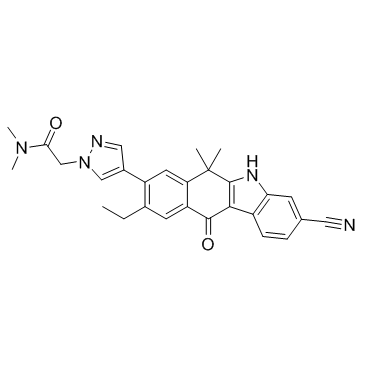1639422-97-1
| Name | JH-VIII-157-02 |
|---|
| Description | JH-VIII-157-02 is a structural analogue of alectinib, acts as an ALK inhibitor, and shows an IC50 of 2 nM for echinoderm microtubule-associated protein-like 4-ALK (EML4-ALK) G1202R in cells. |
|---|---|
| Related Catalog | |
| Target |
IC50: 2 nM (EML4-ALK G1202R, cell assay), 2 nM (EML4-ALKwt, cell assay), 2 nM (EML4-ALK C1156Y, cell assay), 2 nM (EML4-ALK F1174L, cell assay), 2 nM (EML4-ALK F1174L, cell assay)[1] |
| In Vitro | JH-VIII-157-02 is a structural analogue of alectinib, acts as an ALK inhibitor, and shows an IC50 of 2 nM for echinoderm microtubule-associated protein-like 4-ALK (EML4-ALK) G1202R in cells. JH-VIII-157-02 also potently inhibits EML4-ALKwt (Eawt), EAC1156Y, EAF1174L, EAS1206Y (IC50, 2 nM), EAG1269A (IC50, 3 nM), EAL1196M (IC50, 58 nM), EA1151Tins (IC50, 107 nM), and EAL1152R (IC50, 196 nM). Moreover, JH-VIII-157-02 has selectivity at other kinases, including IRAK1, CLK4, RET, RET V804L, RET V804M and IRAK 4, and the IC50s are 14 nM, 14 nM, 3 nM, 13 nM, 12 nM, and 465 nM respectively. JH-VIII-157-02 exhibits inhibitory growth of cancer cell lines, such as H3122, DFCI76 (L1152R] with EC50s of 5, 19 nM, respectively[1]. |
| In Vivo | JH-VIII-157-02 exhibits good oral bioavailability following an oral dose of 10 mg/kg in mice. JH-VIII-157-02 also penetrates the CNS of mice[1]. |
| Cell Assay | Cells are seeded at 4000 per well in 96 well plates and exposed to JH-VIII-157-02 in triplicate at 1 nM to 10 μM for 72 hours. Cell viability is evaluated using CellTiter-Glo Luminescent Cell Viability Assay. IC50 values are calculated by nonlinear regression (variable slope) using GraphPad Prism 5 software. Each experiment is repeated for at least twice[1]. |
| References |
| Molecular Formula | C28H27N5O2 |
|---|---|
| Molecular Weight | 465.55 |
| Storage condition | 2-8℃ |
